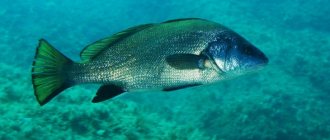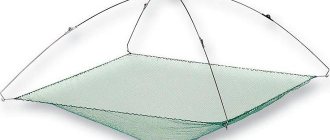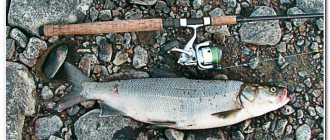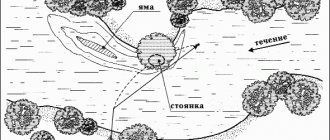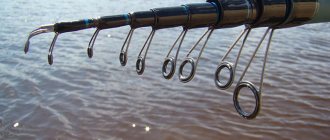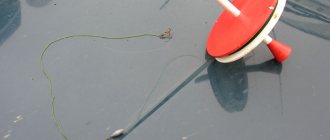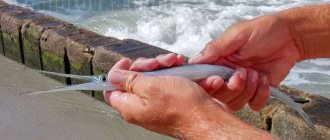Features of sea fishing
Sea fish are superior in strength to the inhabitants of freshwater bodies. Even a small trophy, once hooked, desperately resists. In addition, when fishing in the sea, you need to be prepared for bites from specimens of considerable size, especially if fishing is done from a boat. The weight of predators that may be interested in the bait reaches several hundred kilograms. This must be taken into account when choosing gear.
In the depths of the ocean there is a more active struggle for food resources than in fresh waters. Therefore, the predators that live in them often prefer quick aggressive movements, which are good at provoking them to bite.
In general, sea fishing with a spinning rod involves the use of the same techniques as fishing in fresh waters. Mastering it will not cause difficulties for those who have already mastered the basics of using spinning tackle. This kind of fishing can be combined with a vacation in the south. The Black Sea and Mediterranean coasts, as well as along the shores of any other southern or northern sea, are home to many predators that are constantly looking for food. You just need to present the bait to the fish correctly, and it will not resist the bite.
What kind of fish is found in the Black Sea
About 200 species of fish live in the Black Sea. Some of them, such as blue shark, tuna or swordfish, prefer to stay in the depths, others come close to the shore to feed. Spinning rods most often come across:
- goby;
- scorpionfish, or sea ruff;
- sea crucian;
- greenfinch, or wrasse;
- dog;
- garfish;
- bluefish;
- horse mackerel;
- croaker
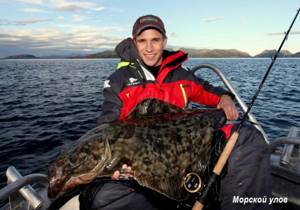
These predators hunt in shallow depths and are caught with a spinning rod from the shore.
Features of coastal fishing
Fishing in hot countries is popular with many, but it is important to choose your gear wisely. Most often, the main requirement is that the rod be rigid and not have a reel or guides. This design is ideal for catching small fish in the coastal zone, such as crucian carp, gobies or mullet. Fishing in the Black Sea from the shore can also be carried out using the Bolognese method: its essence is to use a telescopic rod equipped with an open-type spinning reel and up to 7 m long. The design is convenient for casting into the distance, which makes it possible to catch large sea fish and successfully cope with the resistance of prey when playing.
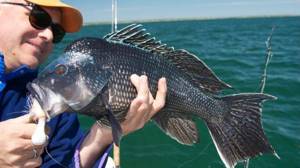
Another cool way to fish from the shore is surf fishing, that is, fishing in the surf. It is good if there is bad weather or a storm at sea, and you are tempted by fishing in the Black Sea from the shore. During prolonged bad weather, microorganisms are thrown ashore - crustaceans, worms, mollusks, on which predators feed. Therefore, fishermen have an excellent opportunity to catch fish that live on a sandy or muddy bottom. A distinctive feature of this method is its long casts, because the places richest in fish are located 10 meters from the shore.
Main fishing spots
At sea they fish from the shore, coastal structures - piers, piers, groins, breakwaters - and from boats.
- Shore fishing is the most popular type of fishing, which can also be called the most sporting. Almost any area of the coast with free access to the water is suitable for it. It is important that at the selected point there are no breakwaters on the way to the open sea - fishing in front of them is practically useless. Where the breakwaters end or there are large openings in them, eddies of water are formed. In such places, predators guard their prey.
- Fishing from structures prominent in the sea has its advantages and disadvantages. The main advantage is the good visibility they provide and the ability to throw bait to fish standing far from the shore. But at the same time, you have to spend a lot of time moving from one groyne to another, and it is difficult to carry out bait at great depths.
- Fishing from boats at sea is done by vertical trolling and trolling. This type of fishing brings big trophies, but many consider it not sporty enough.
Types of spinning rod models
On the market representing products related to fishing equipment, there are two spinning models, one has rings, the other has rollers. The latter, with rollers, is preferred by fishermen. The justification is the fact that the presence of this element reduces the wear of the braid.
Read here Winter float - fishing tactics, choice of gear and methods of using a float (100 photos)
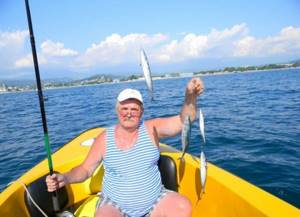
In practice, it has long been established that rings on spinning rods do not have a negative effect on the fishing line. When using the ring model at sea, the role of a lubricant that reduces friction is taken over by salty sea water.
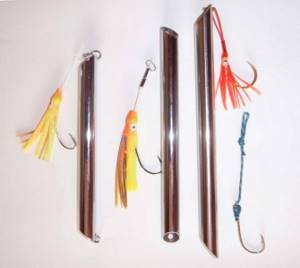
Sea spinning
For fishing in the sea, high-strength gear is used. The length of the rod is selected based on the fishing conditions. Suitable spinning rod sizes are from 1.8 to 3 m. Short rods are suitable for fishing in the ocean depths from a boat, and long rods are used for coastal fishing, as they allow long casts.

There are special sea spinning rods designed for fishing in salt water. They resist its aggressive effects well thanks to the use of special materials and coatings. They also use ordinary gear designed for fishing in freshwater bodies, but after each fishing it is advisable to thoroughly rinse them to remove any remaining salt.
Test
The upper limit of the permissible weight of spinning baits for fishing from the shore can be from 3 to 50 grams. Tests of rods for fishing in the open sea reach several tens of kilograms. This parameter is selected based on the mass of baits and loads used.
Sea fishing reels
For sea fishing, spinning reels of size 1000 and above and multipliers are used. Inertia-free baits are easy to use and allow long-distance casting of light baits. They are best suited for catching small fish from the shore.
Multiplier reels are designed primarily for hunting trophy predators at great depths. They are durable and powerful. Such reels can withstand the resistance of trophy fish well and allow you to confidently pull them towards the boat.
Sea fishing line
To catch small sea fish from the shore, braid with a diameter of 0.1−0.14 mm or monofilament with a thickness of 0.18−0.22 mm is sufficient. Braided line allows you to make long casts and provides the gear with the sensitivity necessary to control the action of the bait.

Also, thanks to the small diameter of the braid, the bait sinks to the bottom more easily, which allows you to comfortably catch sea predators at great depths.
Baits for fishing from the shore
For spinning fishing from the shore use:
- silicone baits. Both standard twisters and vibrotails, as well as crustaceans, octopus and other original shapes, are suitable. They can be used with standard jig equipment or with a bombard. Combing the bottom with a stepped sweep brings good results, but when fishing in rocky places you need to be prepared for snags. Bombards can be floating, slowly sinking and quickly sinking and allow you to fish respectively at the surface, in the middle layers of water and at the bottom.
- Wobblers. More often, heavy wobblers with large blades are used, which go deep to 3-4 meters and attract goby, scorpionfish, horse mackerel, croaker and other sea predators. Floating models and wobblers with a slight depth are suitable for catching garfish.
- Oscillating spinners. The main advantage of these baits is their flight qualities. Jigs are especially well suited for shore fishing, as they can be cast over long distances, catching promising points from the shore.
Catching tyrants "Sabiki"
In Sochi you can also catch large horse mackerel

It’s clear that I had to test all the Japanese “Sabiki” tyrants I bought during my next vacation on the Black Sea. As many amateur fishermen who practice tyrant fishing for mackerel, herring and bluefish know, effective catching of the above fish most often occurs in the open sea, on a vessel equipped with a search sonar. I would like to note that going out to sea on a boat to catch horse mackerel is a rather fussy and expensive business, which does not always promise a good catch and decent well-being, taking into account the fact that rocking with a high wave can completely ruin the fishing fuse. The deck jumping under your feet, the tyrant constantly sinking under the bottom of the boat, bouts of seasickness and the constant expectation of a bite often negates all the delights of going out to sea to catch horse mackerel. It’s another matter if you are going to fish with a tyrant in a plumb line from a pier, pier, breakwater or pier in more or less suitable conditions early in the morning or late in the evening. Often large schools of horse mackerel of different ages come close to the shore to fatten in the evening, when going out to sea on a boat is prohibited. It is for this reason that I prefer to catch horse mackerel exclusively from the pier in a vertical position in the evening, after 20 o’clock, when schools of this fish go into shallow water to hunt for anchovy and silverside. The season for catching horse mackerel with tyrant-type gear, as I think, on the Black Sea begins after August 15, when the water begins to cool to 23-24 degrees in the coastal zone, and at a distance from the shore up to 1 km, the temperature can be 21-23 degrees. It is after the temperature of the sea water decreases that horse mackerel begins to confidently approach the coastal zone for feeding, becoming prey for fishermen on the pier. Also, in mid-August, the spawning season of the Black Sea mackerel ends (lasts from the beginning of May), and after spawning, this type of fish more aggressively and confidently takes any type of bait. I would like to immediately note that often the efficiency of catching such fish as horse mackerel from a pier is somewhat no less than from a boat on the open sea when using an echo sounder! Such unique specimens of horse mackerel in the Black Sea can only be caught by accident
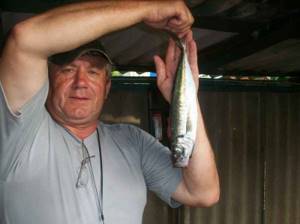
I prefer to fish with a tyrant from a minimum depth of 3 meters, at which you can confidently get stable catches in the evening and at night (approximately active starts to end by midnight), taking into account optimal weather conditions and the presence of a school of horse mackerel in the pier area. Of course, at such depths there is a risk of snags or breakage of the gear if it touches the rocky bottom of the sea or algae such as cystoseira. For this reason, there are several restrictions when fishing from minimum depths on piers, breakwaters, breakwaters and moorings: - fishing depth of at least 3 meters; — the total length of the stake is no more than 1.2 meters; — the amplitude of the “game” by a tyrant with a bet length of 1.2 meters, no more than +/- 1 meter; — absence of boulders, ship wrecks, algae thickets and other objects at the fishing point that sharply change the minimum fishing depth. I am often asked when using tyrant-type gear, do I use bait to attract horse mackerel to the place of future fishing from the pier? Yes, I use bait, but not to attract the horse mackerel specifically to the fishing point, but to ensure the presence of small schools of anchovy, silverside and sprat in this microzone of the sea coast. As is known, horse mackerel feeds on small herring, traveling long distances in the pelagic zone in search of a food item. I specifically create conditions in the fishing zone when, in the evening, silverside, anchovy and sprat find food for themselves on the bottom of the sea or in its thickness, and themselves, being desirable prey for a school of horse mackerel, attract it to a given section of the sea coast. As I have already mentioned in other articles on fishing, to attract different types of fish to the fishing zone, there are primitive methods based on the use of white bread and baits with strong odors, such as camphor and anise oils.
I also recommend the use of ULTRABITE attractants for bottom fishing of nocturnal fish: flounder, sole, etc. To create the bait, I use fresh white “brick” bread, first breaking it in half. I carefully moisten both halves of the “brick” with sea water (I carry out all the manipulations right on the seashore), then I grind the bread on the pier, kneading it with my hands and making the pulp sticky. To the mashed and sticky bread, I add small pebbles (about 20% of the total mass) and grind until smooth. Next, I mold each half into a ball, in which I make a depression with my finger. I pour an attractant or anise (or camphor) oil into the recess. I throw bait balls into the sea at the place of future tyrant fishing within 5-10 meters from the pier. This procedure takes place at 19-20 hours, that is, approximately 1 hour before the start of future horse mackerel fishing with a tyrant from the pier.
With a good wave, the bait balls are completely destroyed after about 20-30 minutes and begin to migrate along the bottom, along with fragments of the attractant or oil, in accordance with the direction of the sea current. In the evening, small schools of anchovy, sprat and silverside begin to approach the particles of bread located at the bottom of the sea or in its thickness. About half an hour after schools of small herring appear, horse mackerel begins to become active in the fishing zone. Unfortunately, this method is only effective when a small wave rises in the evening. If the sea is dead calm, then the abandoned bait will remain on the bottom safe and sound, without having fulfilled its main function - attracting anchovy, sprat and silverside to the place of future horse mackerel fishing.
As mentioned above, when purchasing Japanese tyrants from Sasame and Hayabusa, I expected to test them when fishing for horse mackerel in the Black Sea. We had to test it in Abkhazia, in New Athos (state dacha pier with a depth at the cut of 5 meters) and in Lower Esher (pier to the right of the mouth of the Dzieta River, depth at the cut is 3 meters). I usually fished during strong waves, after 20:00 and before midnight, since I think that all pelagic fish are inactive during calm periods and are rarely suitable for feeding close to the shore. Also, I would like to draw the reader’s attention to the fact that miniature Rappal balancers and spinners, with a certain skill in use, are much more effective than a tyrant at sea, since they create fluctuations in the water column, similar to the movement of small herring. However, these rigs used on spinning rods have one big drawback - they are difficult to use in complete darkness, in conditions of zero visibility.
Often when fishing for horse mackerel in the open sea, you can catch bonito
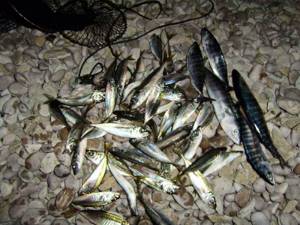
For fishing with tyrants Sasame and Hayabusa, I used the old, long-tested at sea SILRIVER Maestro 180 and a multiplier reel with a line 0.35 mm thick. To play (hook) with a spinning rod in shallow depths, I had to urgently redo the S-607 six-hook tackle from Sasame, which has a stake length of 2.9 m and leashes 17 cm long, shortening the entire structure for convenience. As a result, the total length of the stake with the removal of one leash became 1.5 m, and the length of the leashes decreased to 6 cm. The gear from Hayabusa did not have to be altered, and later it showed itself to be the best in terms of the number of fish caught, but it turned out to be extremely unstable for repeated use. The sinker was applied to both the Sasame tyrant and the Hayabusa weighing 25 and 50 grams of torpedo-shaped type. Retrieving (playing) with both tackles was carried out at different horizons, with manipulation of the tackle at 15-40 cm from the bottom, in the middle layers at 2-3 meters and in the upper layers of 3-5 meters with the stake being released into free fall. The amplitude of the “up and down” oscillations was carried out both with a slowdown, with an interval of 2-3 seconds, and continuously, without pauses. Playing without slowdown, with continuous movement of the gear “up and down,” brought the best results at depths of 2-4 meters. Often horse mackerel stood densely at the bottom, where a school of anchovy settled, attracted by the bait of bread. It was extremely rare to come across individuals weighing 100-130 grams and 20 cm long. Mostly small things were found, 2-3 pieces per stake. In 1 hour it was possible to catch up to 2.5-3 kg of horse mackerel, which, you will agree, in the conditions of fishing on the pier from a minimum depth, is not bad at all. In general, Japanese tyrants have proven themselves in the Black Sea as a very effective and convenient tackle, especially when fishing for horse mackerel at night using an LED headlamp. In particular, I would like to note the following number of their positive qualities: - high quality of execution of the stake and fastening of leashes with hooks; — the presence of fluorescent and phosphorescent colors on streamers, attracting the attention of predatory fish in the absence of light in the water column; — lack of “memory” of the fishing line, with repeated mechanical loads and storage of the fishing gear under tension on a foam reel; — good grip of hooks; — high probability of catching fish with different hook sizes and streamer designs.
Lures for fishing from a boat
For fishing from a boat, casting uses the same baits that are used in shore fishing - silicone, wobblers and oscillating spoons. In this case, you need to select larger models and heavier loads.
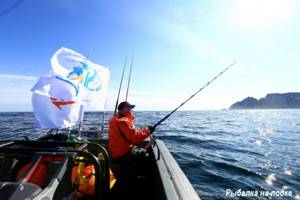
So, if you fish from the shore with a jig with weights weighing from 3 g, then for fishing from a boat you will need heads weighing at least 20-30 g. Jigs are well suited for vertical lures.
Choosing a spinning rod for catching sea fish
The spinning rod, which is a marine variety, is endowed with certain parameters. It can reach up to 2.5 meters in length. This is affected by fishing conditions.

If it is carried out from a boat or vessel, then there is no need to cast the equipment. In this case, fishermen are in the fish zone. Gear for sea fishing from the shore requires a different approach to business.

Test for the weight category of such a spinning rod from 200 to 500 g. The main role in this is played by the weight of the bait used and the fish itself that is supposed to be caught. A rod with large parameters is more difficult to find in fishing stores, but, as a rule, there is no great need for it.
